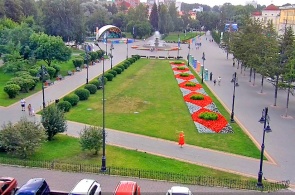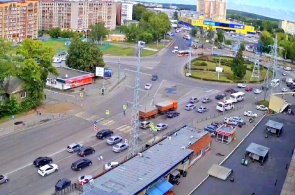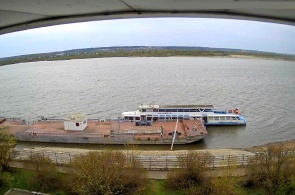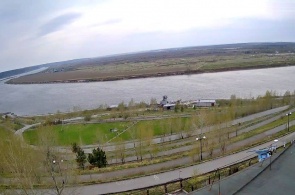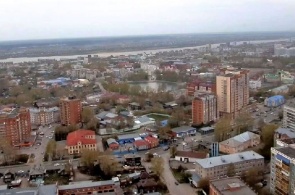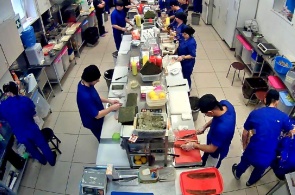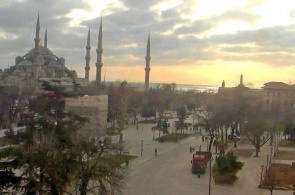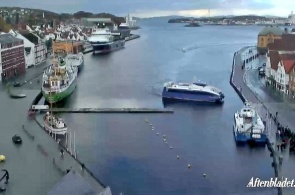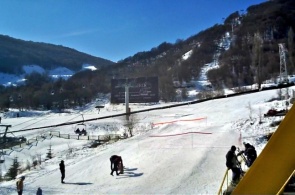Web camera online from South Square in Tomsk. The south square is one of the main squares of Tomsk. The southern square is a major transport hub, and several city buses, trams No. 2, 2A, and 4, trolleybus No. 3, and a trolleybus and a tram ring are running out on the square.
Tomsk was founded in 1604 by decree of Tsar Boris. And the great king said, "Under the city, a place to look, where it is good, and to draw in the drawing, and to take a place to cleanse and ask God for mercy, the city to put in a strong place."
Under the leadership of G. Pisemsky and V. Tyrkov, two hundred Cossacks arrived on the land of Tomsk in the spring of 1604. And the Cossacks decided to build a sharp on the ledge of an ancient river, towering over Tomya. On three sides of the ledge, later it was named Sunday Mountain. He was a precipitous, and even covered from the east rather swamps, from the south flows a small river Ushayka. On the northern, the most dangerous of the sides, built the Cossacks wall of high, pointy to the top pillars.
A new settlement was created on the land of the local Turkic prince Toyan, who accepted Russian citizenship, promising Tsar Boris help in strengthening Russian power in Siberia. According to historians, the Tomsk fortress, repeatedly fought off the constant raids of both Kyrgyz and other steppe peoples. But the importance of Tomsk as a border fortress has significantly decreased, and this is due to the foundation of Krasnoyarsk and Yeniseisk in the first half of the 17th century.
In 1738, the Yam service was opened, which led to the fact that all goods passed exclusively through Tomsk. All this testified to the appearance of numerous services of the Moscow-Siberian tract: artisans, pitmen and blacksmiths. In Tomsk, extensive storage facilities and inn yards were organized. The city began to grow, and its population grew. In addition to the Resurrection Mountain, the city was heavily occupied by other areas: Yury Mountain, Sands, Urgatka, Saozerje, Saistok, Upper and Lower Elani. These historical names are still alive to this day.
The new page in the history of Tomsk is 1804. At this time Tomsk was chosen as the administrative center of the new province. At the same time, the formation of an administrative center, which housed: the city council, the town hall, the magistrate and the police department. In Tomsk, mostly built of wood, construction of stone begins. At first it is natural churches and administrative buildings, and then the houses of the townspeople. It's already to the sulfur. Eight churches were built in Tomsk in the 19th century, as did the construction of the Trinity Cathedral, which was destroyed after the revolution, and 50 stone well-to-do houses.
Tomsk is famous for its attractions, including churches. People came here to pray from the surrounding villages and villages. Unfortunately, not many of the temples, cathedrals and churches survived the revolution, and then two brutal wars. Most of them were abandoned or used as storage facilities. Only in our days have work started to restore them. At the moment, the city has several Orthodox churches, Catholic, Baptist and Muslim mosque, as well as several working monasteries, one of which is within the city limits.
On donations of merchants and large industrialists were built educational and godly institutions, equipped streets. There were sawmills, distilleries and brick factories, mills and a rope factory.
Tomsk province has a huge territory, which once included the territory of the present Altai region, Kemerovo, East Kazakhstan, Novosibirsk, Tomsk regions and even part of the Krasnoyarsk region.
Tomsk had a particularly rapid growth in the 1930s, at a time when the search for gold mines was intensively developed in the Tomsk and Yenisei provinces. In terms of its social and cultural level, Tomsk was higher than almost all Siberian cities (at the turn of the 19th and 20th centuries). Back in 1873, the first public libraries, bookstores, and then a printing house were opened.
From the Tomsk province came bread products, salt, lard, fish, wine, wax, copper and leather.
Tomsk province, considered the main producer of Siberian oil, it accounted for up to 60% of Russia's oil exports. Siberian oils were in no way inferior to direct competitors of Danish and Dutch oil grades.
The Siberian Railway was carried out through the Province of Tomsk in the 1990s. It passed a little south of Tomsk, bypassing wetlands and wooded areas. And in 1896, Tomsk was connected by rail to the main highway of the city. This may not seem like an important circumstance, but it was still important for the development of the village of Novo-Nikolaevska, then it is called Novosibirsk. And it became the main transport hub in the province. Left aside from the main road, Tomsk gradually gave way to the pace of economic development to other Siberian cities, and this is due to the overpowering of Tomsk from the main road.
The population in the Tomsk province grew quite rapidly, but mainly at the expense of exiles. In the first half of the nineteenth century, there were a lot of Ssyntranseestes in Tula - more than 30,000. men and about 7,000. Women. According to statistics, one in five residents of the city and the surrounding area was in exile.
The most significant figure of the Tomsk political exile of that time is G.S.Batenkova. He was a native of Tobolsk, who participated in the war of 1812, where he distinguished himself with courage and courage. Also in St. Petersburg, Gabriel Batenkov became a member of the "Northern Society" of decembrists. After his arrest and imprisonment in the Petropavlovsk fortress, Gabriel was sent to Tomsk, where he lived for 10 years.
In 1880, the construction of the building of the Siberian University began in Tomsk. It was the capital's academician A.K.Bruni who carried out the architectural project of the main building of the educational institution. But even before the construction began, the famous university library was practically formed. One of the main donations for the library was made by Count A.G. Stroganov, a descendant of the oldest kind of Russian industrialists, who gave a very significant book collection to the future university.
Eight years later, in 1888, after the building was built, Emperor Alexander III ordered the opening of the 1st University of Tomsk in Siberia. At the very beginning of its history, it had only one medical faculty, which enrolled 72 students and 2 free students. The famous Russian scientist V.M.Florinsky played a colossal role in the creation of the university.
The first Institute of Technology was opened in 1900. Today it is called the Polytechnic University. Then the teachers', medical and construction institutes were opened.
In the head. The first place in Siberia in terms of the number of educational institutions was occupied by Tomsk (104). Tomsk's cultural life was quite intense. It operated 4 theaters, 5 cinemas, 7 libraries, three entertainment gardens, plus 4 newspapers.
In 1911, 1001 trading companies, 189 factories and factories were registered in the city. In general, the city occupied 15 square meters. Km. Its center was telephoned, electrified and even had not only a water network, but also centralized heating. The population in the city increased to 110,000 people of different faiths, 23 Orthodox churches, a church, a church, three synagogues and two mosques testified. In the encyclopedia of I.Ephron and F. Brockhaus there is a mention that Tomsk was considered the most cultural trade and industrial center in all of Siberia.
In 1917, after the revolution, Tomsk became part of the Siberian, and a little later - the West Siberian region. In 1937, Tomsk and its surroundings became part of the Novosibirsk region.
Back in 1932, Ilya Ehrenburg said: "The fate of different cities was easy to recognize at the station: it was enough to see what bread the locals eat. In Tomsk, the bread was black, wet and heavy: the five-year-old went around Tomsk, and Tomsk was dying." The famous writer added: "Tomsk could have died, but in Tomsk there was a university..." On the eve of World War II, Tomsk had the glory of the city of science, each
The 12th resident was a student of any university.
In the first year of the war, 30 factories were evacuated to the city, which laid the foundation for the industrial development of the city. During the years of World War I, the volume of industrial production in the city tripled.
After the end of World War II, new industries emerged in Tomsk - optical-mechanical, electrical, rubber-technical, significantly "grown" metal processing and engineering, food and light industry.
The post-war development of the city and the region is largely due to the beginning of industrial development of oil and gas fields. In August 1962, the first industrial inflow of oil was produced, at the Sosnin field near the village of Alexandrovskaya. In 1966, the oilfield management was opened. Later, construction of the Alexandrovskaya-Angero-Sudzhensk oil pipeline, the Main Gas Pipeline of Nizhnevartovsk-Parabel-Kuzbass, the bridge crossing over the Tom and Ovod rivers began.
Officially, the Tomsk region was founded on August 4, 1944, with an area of 316.9 thousand square meters. Km. Tomsk again became almost the most visible economic and administrative center of Siberia. It is home to more than 500,000 people, which made up about half of the inhabitants of the region. Tomsk continues to be a forge of personnel and science, annually producing 5,000 specialists with higher and the same number with secondary education.
The old areas of the city are buried in greenery. A memorial complex in memory of the fallen during the Great Patriotic War was built in the Camp Garden.
One of the main attractions of the city was the White Lake, which is located within the city limits. This is one of the most popular holiday destinations not only for the surrounding residents, but also for visitors to the city. Restoration work is regularly carried out to restore the temples and historically valuable buildings of the city.
For 400 years, Tomsk has risen in importance, cultural, social and economic development to the level of cities in Central Russia. Urban buildings, in their appearance, represent a mixture of different architectural styles of different historical eras.
Tomsk was granted the status of a historic city in 1991.
Tomsk was founded in 1604 by decree of Tsar Boris. And the great king said, "Under the city, a place to look, where it is good, and to draw in the drawing, and to take a place to cleanse and ask God for mercy, the city to put in a strong place."
Under the leadership of G. Pisemsky and V. Tyrkov, two hundred Cossacks arrived on the land of Tomsk in the spring of 1604. And the Cossacks decided to build a sharp on the ledge of an ancient river, towering over Tomya. On three sides of the ledge, later it was named Sunday Mountain. He was a precipitous, and even covered from the east rather swamps, from the south flows a small river Ushayka. On the northern, the most dangerous of the sides, built the Cossacks wall of high, pointy to the top pillars.
A new settlement was created on the land of the local Turkic prince Toyan, who accepted Russian citizenship, promising Tsar Boris help in strengthening Russian power in Siberia. According to historians, the Tomsk fortress, repeatedly fought off the constant raids of both Kyrgyz and other steppe peoples. But the importance of Tomsk as a border fortress has significantly decreased, and this is due to the foundation of Krasnoyarsk and Yeniseisk in the first half of the 17th century.
In 1738, the Yam service was opened, which led to the fact that all goods passed exclusively through Tomsk. All this testified to the appearance of numerous services of the Moscow-Siberian tract: artisans, pitmen and blacksmiths. In Tomsk, extensive storage facilities and inn yards were organized. The city began to grow, and its population grew. In addition to the Resurrection Mountain, the city was heavily occupied by other areas: Yury Mountain, Sands, Urgatka, Saozerje, Saistok, Upper and Lower Elani. These historical names are still alive to this day.
The new page in the history of Tomsk is 1804. At this time Tomsk was chosen as the administrative center of the new province. At the same time, the formation of an administrative center, which housed: the city council, the town hall, the magistrate and the police department. In Tomsk, mostly built of wood, construction of stone begins. At first it is natural churches and administrative buildings, and then the houses of the townspeople. It's already to the sulfur. Eight churches were built in Tomsk in the 19th century, as did the construction of the Trinity Cathedral, which was destroyed after the revolution, and 50 stone well-to-do houses.
Tomsk is famous for its attractions, including churches. People came here to pray from the surrounding villages and villages. Unfortunately, not many of the temples, cathedrals and churches survived the revolution, and then two brutal wars. Most of them were abandoned or used as storage facilities. Only in our days have work started to restore them. At the moment, the city has several Orthodox churches, Catholic, Baptist and Muslim mosque, as well as several working monasteries, one of which is within the city limits.
On donations of merchants and large industrialists were built educational and godly institutions, equipped streets. There were sawmills, distilleries and brick factories, mills and a rope factory.
Tomsk province has a huge territory, which once included the territory of the present Altai region, Kemerovo, East Kazakhstan, Novosibirsk, Tomsk regions and even part of the Krasnoyarsk region.
Tomsk had a particularly rapid growth in the 1930s, at a time when the search for gold mines was intensively developed in the Tomsk and Yenisei provinces. In terms of its social and cultural level, Tomsk was higher than almost all Siberian cities (at the turn of the 19th and 20th centuries). Back in 1873, the first public libraries, bookstores, and then a printing house were opened.
From the Tomsk province came bread products, salt, lard, fish, wine, wax, copper and leather.
Tomsk province, considered the main producer of Siberian oil, it accounted for up to 60% of Russia's oil exports. Siberian oils were in no way inferior to direct competitors of Danish and Dutch oil grades.
The Siberian Railway was carried out through the Province of Tomsk in the 1990s. It passed a little south of Tomsk, bypassing wetlands and wooded areas. And in 1896, Tomsk was connected by rail to the main highway of the city. This may not seem like an important circumstance, but it was still important for the development of the village of Novo-Nikolaevska, then it is called Novosibirsk. And it became the main transport hub in the province. Left aside from the main road, Tomsk gradually gave way to the pace of economic development to other Siberian cities, and this is due to the overpowering of Tomsk from the main road.
The population in the Tomsk province grew quite rapidly, but mainly at the expense of exiles. In the first half of the nineteenth century, there were a lot of Ssyntranseestes in Tula - more than 30,000. men and about 7,000. Women. According to statistics, one in five residents of the city and the surrounding area was in exile.
The most significant figure of the Tomsk political exile of that time is G.S.Batenkova. He was a native of Tobolsk, who participated in the war of 1812, where he distinguished himself with courage and courage. Also in St. Petersburg, Gabriel Batenkov became a member of the "Northern Society" of decembrists. After his arrest and imprisonment in the Petropavlovsk fortress, Gabriel was sent to Tomsk, where he lived for 10 years.
In 1880, the construction of the building of the Siberian University began in Tomsk. It was the capital's academician A.K.Bruni who carried out the architectural project of the main building of the educational institution. But even before the construction began, the famous university library was practically formed. One of the main donations for the library was made by Count A.G. Stroganov, a descendant of the oldest kind of Russian industrialists, who gave a very significant book collection to the future university.
Eight years later, in 1888, after the building was built, Emperor Alexander III ordered the opening of the 1st University of Tomsk in Siberia. At the very beginning of its history, it had only one medical faculty, which enrolled 72 students and 2 free students. The famous Russian scientist V.M.Florinsky played a colossal role in the creation of the university.
The first Institute of Technology was opened in 1900. Today it is called the Polytechnic University. Then the teachers', medical and construction institutes were opened.
In the head. The first place in Siberia in terms of the number of educational institutions was occupied by Tomsk (104). Tomsk's cultural life was quite intense. It operated 4 theaters, 5 cinemas, 7 libraries, three entertainment gardens, plus 4 newspapers.
In 1911, 1001 trading companies, 189 factories and factories were registered in the city. In general, the city occupied 15 square meters. Km. Its center was telephoned, electrified and even had not only a water network, but also centralized heating. The population in the city increased to 110,000 people of different faiths, 23 Orthodox churches, a church, a church, three synagogues and two mosques testified. In the encyclopedia of I.Ephron and F. Brockhaus there is a mention that Tomsk was considered the most cultural trade and industrial center in all of Siberia.
In 1917, after the revolution, Tomsk became part of the Siberian, and a little later - the West Siberian region. In 1937, Tomsk and its surroundings became part of the Novosibirsk region.
Back in 1932, Ilya Ehrenburg said: "The fate of different cities was easy to recognize at the station: it was enough to see what bread the locals eat. In Tomsk, the bread was black, wet and heavy: the five-year-old went around Tomsk, and Tomsk was dying." The famous writer added: "Tomsk could have died, but in Tomsk there was a university..." On the eve of World War II, Tomsk had the glory of the city of science, each
The 12th resident was a student of any university.
In the first year of the war, 30 factories were evacuated to the city, which laid the foundation for the industrial development of the city. During the years of World War I, the volume of industrial production in the city tripled.
After the end of World War II, new industries emerged in Tomsk - optical-mechanical, electrical, rubber-technical, significantly "grown" metal processing and engineering, food and light industry.
The post-war development of the city and the region is largely due to the beginning of industrial development of oil and gas fields. In August 1962, the first industrial inflow of oil was produced, at the Sosnin field near the village of Alexandrovskaya. In 1966, the oilfield management was opened. Later, construction of the Alexandrovskaya-Angero-Sudzhensk oil pipeline, the Main Gas Pipeline of Nizhnevartovsk-Parabel-Kuzbass, the bridge crossing over the Tom and Ovod rivers began.
Officially, the Tomsk region was founded on August 4, 1944, with an area of 316.9 thousand square meters. Km. Tomsk again became almost the most visible economic and administrative center of Siberia. It is home to more than 500,000 people, which made up about half of the inhabitants of the region. Tomsk continues to be a forge of personnel and science, annually producing 5,000 specialists with higher and the same number with secondary education.
The old areas of the city are buried in greenery. A memorial complex in memory of the fallen during the Great Patriotic War was built in the Camp Garden.
One of the main attractions of the city was the White Lake, which is located within the city limits. This is one of the most popular holiday destinations not only for the surrounding residents, but also for visitors to the city. Restoration work is regularly carried out to restore the temples and historically valuable buildings of the city.
For 400 years, Tomsk has risen in importance, cultural, social and economic development to the level of cities in Central Russia. Urban buildings, in their appearance, represent a mixture of different architectural styles of different historical eras.
Tomsk was granted the status of a historic city in 1991.
More details
Tomsk webcam is located on Novosobornaya Square. The video shows the square itself with a fountain, flower beds, a summer stage and green spaces, as well as surrounding buildings and objects. Filming is carried out online all the time.
Tomsk, Russia
20.08.24
The web camera broadcasts the Transport Square online - the unofficial colloquial name of the transport ring just north of the Square South at the junction of the streets of Krasnoarmey, Kiev, Akhimov and Elizarov. It is located in the Kirov district of Tomsk.
Tomsk, Russia
16.08.20
The web camera online broadcasts the intersection of Lenin Avenue - Tikhy lane in Tomsk. Tomsk is a city founded in 1604, which is located in the east of Western Siberia, on the banks of the Tom River. Its foundation was the result of the development of Siberia by Ermak and his team.
Tomsk, Russia
16.08.20
The webcam transmits real-time views of the city Tomsk. Web camera installed on the tower and captures an overview of much of the city Tomsk.
Tomsk, Russia
18.05.19
Web Cam broadcasting real time kitchen sushi online "Panda" RESTORANTS in the city of Tomsk.
Tomsk, Russia
18.05.19
popular camerasshow all
Sultanahmet or Blue mosque is a work of art of Turkish-Islamic architecture. Its construction began in 1609, the construction work took seven years to a 19-year-old Sultan. The name of the mosque was, due to its interesting and unique finish.
Istanbul, Turkey
08.02.14
Stavanger, a town in the commune of Norway, located in the South-Western part of the country, on the Peninsula, rich in minerals. Tanager combines the influence of foreign organisations such as NATO and oil companies. The camera will shoot the harbour and the promenade of the city.
Stavanger, Norway
03.11.13
A webcam broadcasts the district of Tosmur - quiet location in the Eastern part of Alanya, located only five kilometres from the city centre. Its rural way of life and the beauty of untouched nature attract tourists.
Alanya, Turkey
10.11.18
Shark Island or in English of Shark island, located in the harbour city of Sydney, the suburb of Point Piper. The locals, the natives named the island Boambilly, which translated means Shark island. After all, this name is not casual, because it's mean and looks like a shark fin.
Sydney, Australia
31.10.13
The webcam is installed on site Alva. Tsaghkadzor ski resort town in Armenia. Tsaghkadzor is a beautiful mountainous area among deciduous forests, with a pleasant winter climate, and clean fresh air. The highest point is 1800 meters. The truss type is a classic, divided into three.
Tsakhkadzor, Armenia
18.01.14

